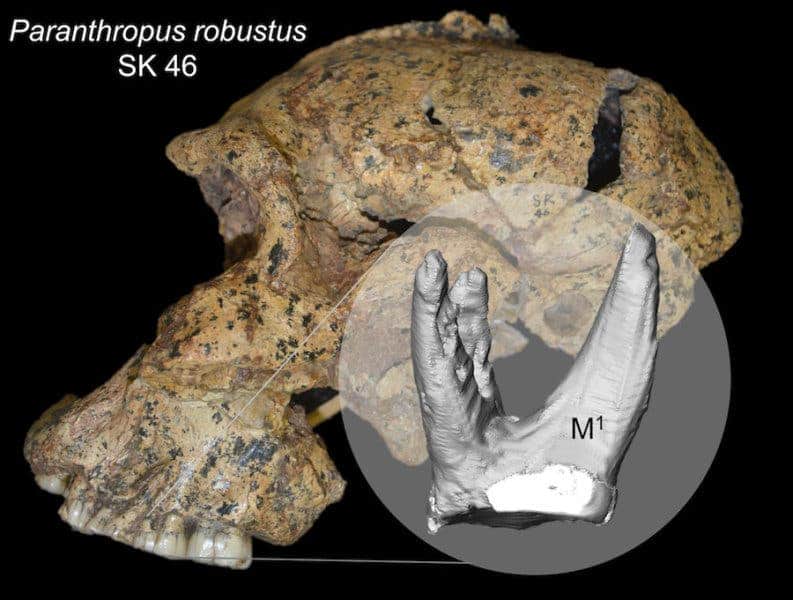Not all human ancestors chewed the same way, new research reveals.

Paranthropus robustus fossil from South Africa SK 46 (discovered 1936, estimated age 1.9-1.5 million years) and the virtually reconstructed first upper molar used in the analyses.
Image credits Kornelius Kupczik / Max Planck Institute for Evolutionary Anthropology.
While we’re the only one that made it up to the present, we’re by no means the only species of hominins — the evolutionary group that includes modern humans and now-extinct bipedal relatives — that popped up throughout history. At least one of our human ancestors, new research shows, developed a unique way to chew.
Ancient chow
Being able to properly chew your food is a matter of life and death. It helps break food down into tiny pieces so they can be swallowed and digested. But every species has its own way of going about it — based on their diet and individual morphology.
You can learn a lot about an animal by looking at what it eats and the way it chews on it, and that stands true for humans as well as wildlife. Palaeoanthropologists go to great lengths to reconstruct the diets of ancient hominid species, as diet underpins our evolutionary history. A high-quality diet, for example, coupled with meat-eating, provided the nutrients that modern humans needed to develop our big brains. Some of our hominin relatives, by contrast, likely went extinct because of their diets (for example, the Neanderthals).
Two extinct hominin lineages — Australopithecus africanus and Paranthropus robustus — have constantly sparked debate in regards to their diet since their discovery. An international team of researchers, led by members from the Max Planck Institute for Evolutionary Anthropology, studied the splay and orientation of their fossil tooth roots in an attempt to settle the debate once and for all. Their findings surprisingly reveal that P. robustus employed a unique way of chewing food — one that hasn’t been seen in any other hominin species to date.
The team used high-resolution computed tomography and shape analysis to determine how teeth roots were oriented within the jaw of ancient hominin lineages. Based on this information, they then gauged the direction of the load during mastication — i.e. the direction force was applied while they chewed.
By comparing the virtual reconstructions of 30 hominin first molars from lineages in South and East Africa, the team found that Australopithecus africanus had much more widely-splayed roots than either Paranthropus robustus or the East African hominin Paranthropus boisei. This yielded a surprising revelation about P. robustus.
“This is indicative of increased laterally-directed chewing loads in Australopithecus africanus, while the two Paranthropus species experienced rather vertical loads,” says Kornelius Kupczik of the Max Planck Institute for Evolutionary Anthropology, first author of the paper.
Unlike all other hominins involved in the study, P. robustus showed a ‘twist’ in the roots of their teeth — suggesting a slight rotational and back-and-forth movement while chewing, the team explains. Other characteristics of their skulls support this observation, they add: the structure of the enamel also points towards a complex, multi-directional motion. Microwear patterns in the enamel (which the team reports are “unique among primates”) also point to a different motion of the jaw while masticating compared to how we do it, for example.
While diet also has a major part to play in shaping our and P. robustus‘ skulls, as well as in the patters of wear observable on their teeth, the team says dietary differences alone cannot account for all that they’re seeing.
“Perhaps palaeoanthropologists have not always been asking the right questions of the fossil record: rather than focusing on what our extinct cousins ate, we should equally pay attention to how they masticated their foods,” concludes co-author Gabriele Macho of the University of Oxford.
The research could have implications beyond paleoanthropology, the team explains. By studying the particularities of P. robustus‘ morphology, its mastication patterns, and its effect on the lineage’s teeth, “we can eventually apply such findings to the modern human dentition to better understand pathologies such as malocclusions,” explains co-author Viviana Toro-Ibacache.
The paper “On the relationship between maxillary molar root shape and jaw kinematics in Australopithecus africanus and Paranthropus robustus” has been published in the journal Royal Society Open Science.









